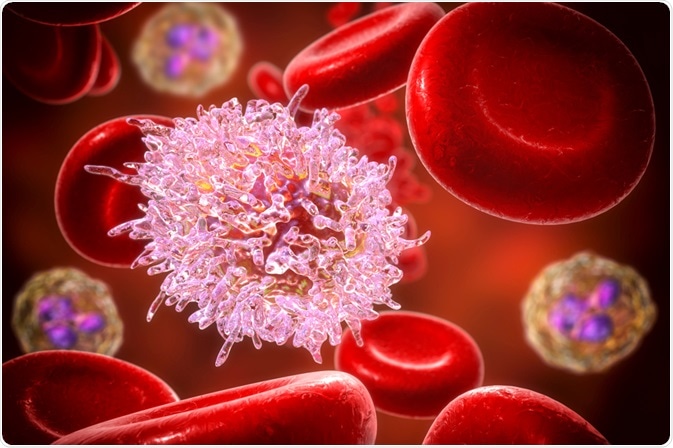Hairy cell leukemia is a form of chronic lymphoid leukemia characterized by a build-up of abnormal B-lymphocytes. It is a cancer of the blood and bone marrow that either progresses slowly or does not worsen at all. The name hairy cell leukemia was first used to describe the condition in 1966, based on the hair-like projections that surround the abnormal cells on microscopic examination.
 Image Credit: Kateryna Kon/Shutterstock.com
Image Credit: Kateryna Kon/Shutterstock.com
Hairy cell leukemia is a rare condition that accounts for just 2% of all cases of leukemia, meaning around 600 to 800 people are diagnosed with the illness each year. The disease is more common among white individuals and is rarely reported in those of Japanese or African descent. The incidence among men is around four times greater than among women and the median age for onset among men is 52 years. Hairy cell leukemia was previously called histiocytic leukemia, lymphoid myelofibrosis or malignant reticulosis.
Disease features
Normally, immature cells called stem cells are generated by the bone marrow and these eventually become mature blood cells. The blood stem cells may become either myeloid stem cells or lymphoid stem cells. The myeloid stem cell gives rise to three types of mature blood cells including the red blood cell, which transports oxygen and nutrients around the body; the white blood cell, which fights disease and platelets, which are required for blood clotting to prevent bleeding.
A lymphoid stem cell, also referred to as a lymphoblast, goes on to become a B lymphocyte, a T lymphocyte or a natural killer cell. B-lymphocytes are needed to make antibodies for fighting infection; T lymphocytes help the B-lymphocytes produce antibodies and natural killer cells target and kill viruses and cancer cells.
In hairy cell leukemia, too many of the blood stem cells develop into lymphocytes, which are abnormal and never become healthy cells. Also called leukemia cells, these accumulate in the blood and bone marrow disrupting the usual balance of the normal white blood cells that are there, as well as that of the red blood cells and platelets.
Consequently, there are fewer healthy white blood cells available to fight infection, a deficiency of red blood cells eventually causes anemia and a shortage of platelets means bleeding is more likely. In addition, the leukemia cells also sometimes accumulate in the spleen and cause the structure to swell, which may be felt as a lump in the left abdomen.
New DNA scanning methods have recently identified a mutation in the BRAF (v-raf murine sarcoma viral oncogene homolog B1) gene in patients with hairy cell leukemia. This missense somatic clonal mutation may be involved in the pathogenesis of the condition, as well as providing a target for diagnosis and therapy.
Hairy cell Leukemia made Easy|White Blood Cell disorders|#hairycellleukemia#usmle#chronicleukemias
Treatment of hairy cell leukemia
As hairy cell leukemia does not always progress or only progresses slowly, treatment is not always necessary and patients may prefer to wait until the condition is causing signs or symptoms. However, most people with hairy cell leukemia do eventually require treatment, which while it cannot cure the condition, is usually effective at putting the cancer into remission for a period of years. The first treatment approach to hairy cell leukemia is chemotherapy. The two drugs that are used include cladribine and pentostatin which are both administered intravenously. Other treatments available include biological therapy using interferon or rituximab and surgery to remove the spleen and help restore a normal blood count.
References
Further Reading